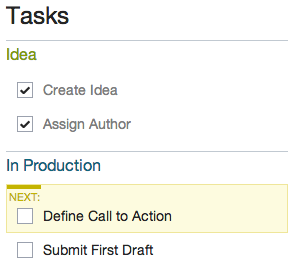
Calls to action are the springboards that launch your buyers toward purchase.
According to Copyblogger, a call to action is “the most effective tactic to convert random traffic into loyal readers and paying customers.” That’s a pretty impressive definition–and one that should pique (thank you for the grammar correction, Brian Clark) the interest of any content marketing practitioner.
Driving traffic, generating leads, and increasing revenue are the very real benefits of a well-executed content marketing strategy–and calls to action are the springboards that launch your buyers toward purchase.
There are lots of articles that cover how to create effective calls to action (see below), but the question that really interests me is this: when it comes to content marketing assets such as eBooks, blog posts, articles, social media promotions, and beyond, when do you define your call to action? When do you decide that, yes, this is what I want the visitor to do?
Hopefully, you answered, “before I ever lay finger to keyboard and begin to type.”
That’s right. A call to action should never be an afterthought. It needs to be defined from the very start.
Now, let’s get a little zen. Defining goals and setting intentions are longtime and proven practices for those seeking personal and professional growth. Understanding what you want to achieve gives more purpose to your actions, and you subconsciously make decisions that move you toward those goals. I work with a number of people from Fairfield, Iowa who meditated as part of their elementary schooling, so if you need further convincing that this is a real and powerful concept, let me know. I’ll put you in touch.
But I digress.
Setting intentions in life can drive powerful results, and the same goes for setting goals in content creation. By defining the action you want your reader to take before you begin to write, you’ll create content with that goal top of mind. And when you know what you want from a piece of content, it’s far easier to create a seamless, relevant transition from educating your visitors to encouraging them to take that desired step.

Calls to action are an important part of content creation workflow.
We’ve actually made CTAs an important part of our blog post workflow for each and every piece published on the Content Marketeer. Right after a content idea is submitted and the author assigned to that project, the call to action must be defined, usually by the managing editor. Most of the time, the CTA is pretty obvious and is identified during the planning stage. For example, if you’re writing a blog post to promote an upcoming webinar, the CTA will most likely be to register for that webinar.
But when a fantastic idea comes in from a sales rep, or someone in customer support shares a brilliant customer question that is begging to be a piece of content, you need to add that idea to your editorial calendar, see what important campaigns (timely or ongoing) you’re running at that time (Event promotion? Increase newsletter subscription? EBook download?) and define a call to action that the content piece will complement.
Only then should the author commence with content creation.
Every piece of content you create for content marketing efforts should have a business goal and purpose, and defining that purpose up-front will help you nail down those calls to action. As Chris Brogan explains, “If you’re not putting some kind of potential hook to future business into your efforts, you’re not content marketing. You’re writing.”
And that is why defining calls to action from the start is so important–it’s how you can successfully convert visitors into leads into customers, which is the whole essence of this content marketing thing.
Now, here are those links I mentioned earlier, which reference some key ways to ensure you’re doing content marketing–purposeful, successful content marketing–that inspires action:
- 20 Do’s & Don’ts for Clickable Calls-to-Action via HubSpot
- Creating Engaging Content: 3 Calls to Action that Get Conversions via Content Marketing Institute
- 12 Ways to Strengthen Your Call to Action in Email via MarketingProfs
- 20 Mistakes that Will Undermine Your Call to Action and Cost You Sales via Copyblogger
Interested in more tips? Join hundreds of marketers by subscribing to our weekly roundup of posts from the Content Marketeer.
